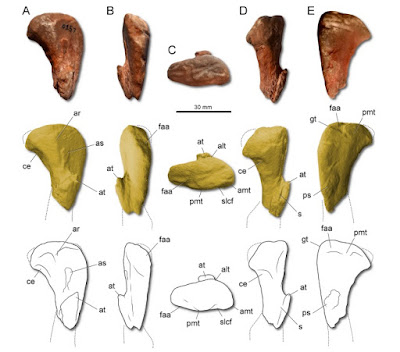 |
| Erythrovenator jacuiensis Müller, 2020 Illustration: Márcio L. Castro. |
Highlights:
• A new theropod dinosaur from the Late Triassic of Brazil is described.
• It is one of the oldest known theropods worldwide.
• This sheds light on some of the earliest theropod features.
• The new theropod comes from a peculiar fauna dominated by traversodontid cynodonts.
• The new theropod represents the first carnivorous dinosaur from this assemblage.
Abstract
The early evolution of theropod dinosaurs is poorly understood. Whereas sauropodomorphs are well-known from the oldest dinosaur bearing outcrops, the record of theropods is fragmentary and ambiguous. The Triassic deposits from Brazil yielded some of the oldest dinosaurs worldwide. These dinosaurs came from two distinct Assemblage Zones (AZ): the Hyperodapedon AZ (Carnian) and the Riograndia AZ (early Norian). Here, a specimen previously assigned to cf. Dinosauromorpha is reassessed. CAPPA/UFSM 0157 comes from an enigmatic assemblage with predominance of the traversodotind cynodont Siriusgnathus. This assemblage has been tentatively assigned to the Riograndia AZ. However, the absence of index fossils still hampers a reliable assignation. The specimen, which comprises a proximal portion of a left femur, belongs to a new theropod taxon erected here as Erythrovenator jacuiensis gen. et sp. nov. The new dinosaur differs from all other known Triassic dinosaurs based on the absence of a raised dorsolateral trochanter of the femur. Erythrovenator jacuiensis gen. et sp. nov. is regarded as a theropod on the basis of the pyramidal shape of the anterior trochanter in anterior view. The results of a phylogenetic analysis corroborate this assignation. Therefore, the new dinosaur represents one of the oldest theropod dinosaurs worldwide, shedding lights on some of the earliest theropod features. Finally, the new specimen also represents the first carnivorous dinosaur from the assemblage dominated by the traversodontid cynodont Siriusgnathus, increasing our knowledge of the faunal content of this enigmatic assemblage.
Keywords: Archosauria, Candelária sequence, Carnian, Dinosauromorpha, Norian, Theropoda, Saurischia, South America

Systematic Paleontology
Dinosauriformes Novas, 1992
Dinosauria Owen, 1842
Theropoda Marsh, 1881
Erythrovenator gen. nov.
Etymology. ‘Erythro’ comes from the Greek erythrós, meaning “red” or “reddish”, referring to the red color of the holotype fossil; ‘venator’ is the Latin word for hunter.
Erythrovenator jacuiensis sp. nov.
Etymology. The species name ‘jacuiensis’ is in reference to ‘Rio Jacuí’, a river that runs in Agudo.


Rodrigo T. Müller. 2020. A New Theropod Dinosaur from A Peculiar Late Triassic Assemblage of southern Brazil. Journal of South American Earth Sciences. In Press. DOI: 10.1016/j.jsames.2020.103026










